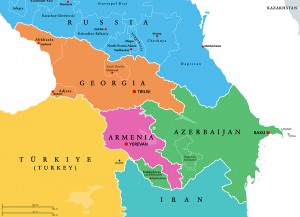Fleeing Artsakh: Q &A with Armenian Studies Professor Vahram Shemmassian

Credit: iStock-Peter Hermes Furian.
Recent events in Armenia have ignited demands for peace and justice in the region and have hit close to home for many of our CSUN students and campus community. Los Angeles County is home to one of the largest populations of Armenians outside of Armenia and it is estimated that 10% of CSUN’s 36,000 students identify as Armenian.
On Sept. 20, the military of neighboring Azerbaijan seized control of the Nagorno-Karabakh* region — known by Armenians as Artsakh – the ancestral homeland of tens of thousands of ethnic Armenians. The violent seizure prompted Artsakh leadership to dissolve its government and thousands of civilians to flee the region through the Lachin Corridor toward southern Armenia.
This sudden military action against Artsakh has sent shockwaves through Armenian communities across Los Angeles. Its members responded quickly by organizing aid and donation efforts. Many rallied to bring attention to the crisis.
“The tragedy unfolding in Artsakh weighs heavily on our minds in our campus community,” CSUN President Erika D. Beck said. “The deadly seizure of traditional Armenian homeland is causing yet another humanitarian crisis amongst a population that has suffered so much loss, from the Armenian Genocide of 1915 to the present day. We stand in solidarity with the Armenian people who have dealt for months with shortages of food, medical supplies and basic necessities — and are now forced to move from their homeland, in fear for their lives. Our hearts go out to our colleagues and students who also have been impacted by these horrific events.”
CSUN Today asked Professor Vahram Shemmassian, head of the Armenian Studies Program within the Department of Modern and Classical Languages and Literatures in the College of Humanities. to answer our questions about Artsakh and describe what the future might hold for the thousands of Armenian refugees.
Can you describe the Artsakh region for those who may not be familiar with the area?
I have been to Artsakh twice, in 2005 and 2009. The mountainous landscape is extremely beautiful and rich in flora and fauna. There are also important and precious metals and mineral ores that can be extracted for good use. The villages and villagers are unadulterated, something you don’t find much in the Western world.
What is the significance of Artsakh to the Armenian people—and what is being lost as a result of its dissolution?
Artsakh is the only province in Armenian history where the Armenians have existed for millennia without interruptions. This permanence has now disappeared with military might and usurpation. The land is home to numerous irreplaceable cultural monuments such as ancient and medieval monasteries, Armenian inscriptions, unique khachkars (carved cross stones), bridges, fountains, cemeteries, etcetera. As during and after the Armenian Genocide in the early 20th century, this heritage, which is part of world civilization, is now being erased.
What concerns are there for the refugees as they arrive in Armenia?
The coming weeks, months and even years are bleak. The influx of refugees in Armenia will create all sorts of difficulties: economic, housing, health, social, educational, political, etcetera. Uprooted, shocked and frustrated, the traumatized population may cause problems to the government and/or may be manipulated by opposition forces to pursue their agendas — whether out of genuine patriotic concerns or doing the bidding of greater powers such as Russia. Armenia is a small and landlocked country with fewer than 3 million inhabitants. This new burden on its shoulders will be tackled with much difficulty.
What are you hearing from students and others in the CSUN community about this crisis?
Some students are silent because of the shock, others want to help their Artsakh brothers and sisters now in Armenia. A number of students are also active in the community through organizations — collecting money, clothing, medicines, etcetera. Volunteerism among Armenians of the diaspora is quite strong, and what the students do reflects that.
How can people help? Are there organizations that are particularly helpful to the people of Artsakh right now?
There are several organizations that have a proven record of philanthropy and are reliable: the Armenian General Benevolent Union (AGBU), founded in 1906, and the Armenian Missionary Association of America (AMAA), established in 1918, to name but two.
In addition, Professor Crist Khachikian in the College of Engineering and Computer Science, recommends donations to the Focus on Children Now organization, as well as All for Armenia and ReArmenia.
CSUN Students who need mental health support during these difficult times may connect with University Counseling Services through their website.
*The Associated Press uses Nagorno-Karabakh, as do other news organizations. CSUN Today follows AP Style guidelines by using this name, in addition to Artsakh.

 experience
experience